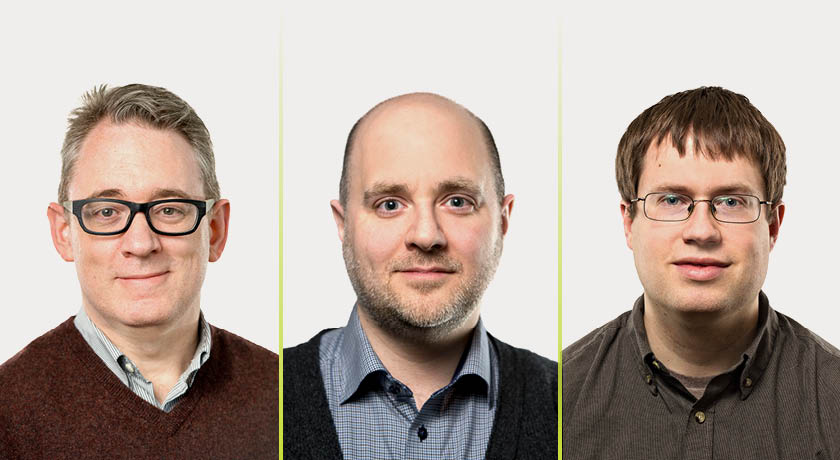
L to R: Todd Lowary (chemistry), Darren Grant (physics), and Zachary Friggstad (computing science)
The Faculty of Science has been awarded three new Canada Research Chairs, including one Tier 1 Chair, (a $1.4-million award to be paid out over seven years), and two new Tier 2 Chairs (each worth $500,000 to be paid out over five years).
Todd Lowary (chemistry) was a warded a Tier 1 chair in carbohydrate chemistry, Darren Grant (physics) was named as the CRC in astroparticle physics, and Zachary Friggstad (computing science) is the new CRC in combinatorial optimization.
Lowary, who celebrated the official launch of the Canadian Glycomics Network, or GlycoNet, on April 10, says it is his hope to continue carbohydrate research excellence in the U of A's Department of Chemistry that goes back a half century.
Beginning in the early 1950s, U of A chemistry professor Raymond Lemieux and his colleagues were the first to synthesize sucrose, which paved the way for the creation of new antibiotics and blood reagents. Chemistry professor David Bundle was part of the U of A team headed by Raymond Lemieux that developed the first synthetic blood-group antigens in the early 1970s. The achievements of Bundle's lab, in which Lowary played an integral role, include a new sugar molecule to block the toxins caused by bacteria such as E. coli and cholera.
Lowary's proposed research program will use carbohydrate chemistry to provide molecules that can be used to explore the function of carbohydrates, or glycans, in mycobacterial diseases, including tuberculosis, as well as food-borne infections including those caused by infection with campylobacters and E. coli.
"Broadly speaking, this university has had strength in this area for more than 50 years and I am proud to be a continuation of that legacy," said Lowary.
Unlocking the mystery of neutrinos
Darren Grant, a professor in the Department of Physics and the head of DeepCore, the low-energy extension of the IceCube Neutrino Observatory located in the Antarctic, has dedicated his career to the detection and understanding two of the universe's most elusive particles-neutrinos and dark matter.
"A neutrino is a subatomic particle, a foundational particle, from which the universe is made," said Grant. "They're everywhere, billions of them passing through us every second-they go right through and they don't interact. But we don't know very much about them, they are one of nature's great mysteries to study."
What little there is to know about the neutrino, Grant's work has played a role in discovering. His PhD thesis on the Sudbury Neutrino Observatory demonstrated that neutrinos have mass, providing the first evidence for physics beyond the Standard Model of Particle Physics.
He says his CRC is the next step in the design and construction of a new generation of neutrino detectors, and helps further the U of A's position in this field. The U of A is Canada's first IceCube collaboration institute, one of the four founding members of Canada's National Laboratory for Particle and Nuclear Physics and a full member of the SNOLAB Institute, which operates Canada's International Facility for Underground Science in Sudbury.
"The U of A offers an exceptional environment for research in astroparticle physics," he said. "This is exemplified by the infrastructure that has been developed in the Department of Physics and the Centre for Particle Physics over the last two decades. The U of A's infrastructure for subatomic research is second to none at Canadian universities, as are the technicians, technical resources and funding."
Coping with Computational Intractability
Zachary Friggstad has been making a name for himself removing some of the fright from some of the most daunting logistical nightmares since his earliest days as a grad student at the U of A.
Despite massive computing clusters, Friggstad says these classic optimization problems-such as the coordination of fleets of vehicles and locating distribution centres to routing wires in large-scale circuit design-are intractable, meaning there is expectation that there would ever be an efficient enough algorithm to solve them.
Of course, that hasn't stopped Friggstad from trying.
A classic optimization problem would be finding the optimal number of facilities to serve the maximum number of clients, while minimizing the costs of serving clients-a problem for which Friggstad developed an approximation algorithm with his master's thesis in 2007.
His early and profound understanding of this field put him in the driver's seat when he began searching for a post-secondary institution to further his academic career.
"One of the things that made me make a personal decision about joining the Department of Computing Science was it seemed that there was a real interest in collaboration and adding a theoretical foundation to their work," he said.